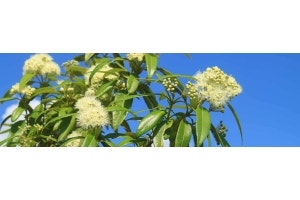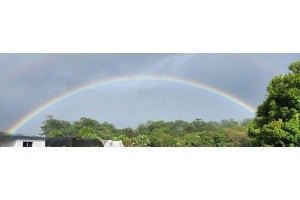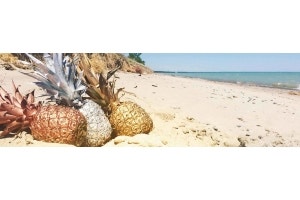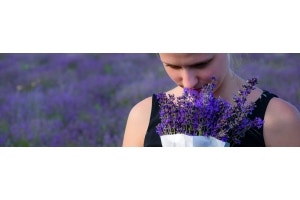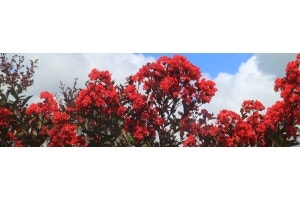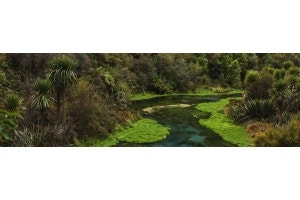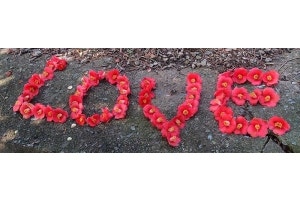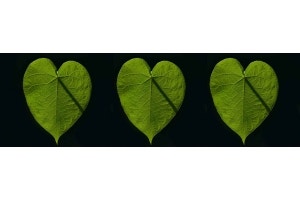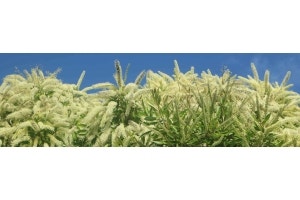
Banksia - the iconic Aussie
Banksias are an iconic Australian plant, unmistakable in appearance. They're tough natives, able to thrive in difficult climates and soils. Birds and nectivorous mammals love the sweet flowers. And they always have flowers or cones to enjoy.
Banksia Variety
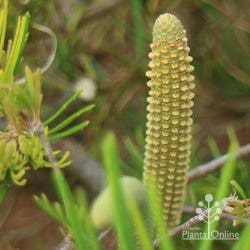
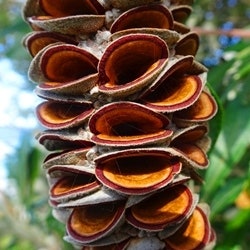 There are around 170 different species of Banksia, and all but one are native to Australia and nowhere else. Some are east coast natives, some prefer the west coast, some are happy almost anywhere, while some will only grow in very specific limited locations in the wild.
Some banksia are little more than ankle-high, hiding their flowers beneath their leaves; while some grow into huge rangy trees adorned with distinctive golden-cream cylinders like giant candelabras.Banksia flowers grow and evolve from buds - called candles, shown here - to the cylindrical flowers, which often open from the bottom upwards, to give a two-tone colour and texture. These flowers then turn into seed pods which can be hairy or velvety, often darkening in colour as they mature. Pods will open in heat or after fire, creating the 3D effect shown in the second image. Banksias usually retain old flowers and cones on the plant for many months, so you can see all stages of the flower at once.
There are around 170 different species of Banksia, and all but one are native to Australia and nowhere else. Some are east coast natives, some prefer the west coast, some are happy almost anywhere, while some will only grow in very specific limited locations in the wild.
Some banksia are little more than ankle-high, hiding their flowers beneath their leaves; while some grow into huge rangy trees adorned with distinctive golden-cream cylinders like giant candelabras.Banksia flowers grow and evolve from buds - called candles, shown here - to the cylindrical flowers, which often open from the bottom upwards, to give a two-tone colour and texture. These flowers then turn into seed pods which can be hairy or velvety, often darkening in colour as they mature. Pods will open in heat or after fire, creating the 3D effect shown in the second image. Banksias usually retain old flowers and cones on the plant for many months, so you can see all stages of the flower at once.
Banksia Care
Most banksias are found naturally in sandy and gravelly soils, free-draining and light, of neutral or acid pH; in dappled shade understorey, or full sun. Mature plants will often regenerate after fire.Almost all banksias hate having soggy wet roots and will suffer if drainage is not good. They also need feeding with low-phosphorus fertiliser, as over-rich heavily fertilised soils can damage their roots.At Australian Plants Online we mainly offer the more adaptable banksias, the ones that are happy in the drier climates of the west and southern states and the poor soils of coastal and upland sites, but that will also grow in humid east coast climates and richer soils of gardens.This means that you have the best chance of them thriving in your own garden.
The Big Four
The Big Four banksia species collected by Joseph Banks and Daniel Solander on the Endeavour's voyage to what would be called Botany Bay, are : ericifolia the heath banksia; integrifolia the coast banksia; robur the swamp banksia; and serrata, the saw banksia. Meet them here:
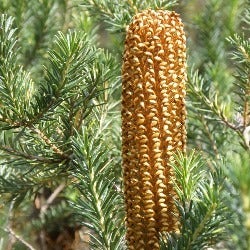
Banksia ericifolia - heath banksia
This adaptable Banksia is found in NSW on sandy acid soils, where it grows alongside tea tree and hakea. The leaves are small and slender - ericifolia means heather-like-leaf; and the long slender flowers are deep orange, and very neat. They are very popular with nectar-loving birds and mammals.Heath banksia can get to 6m tall but mostly is half that or even smaller, which makes it an easy size for most gardens. It is the official flower of Sydney.It is very popular in horticulture for hybridising, and many cultivars are derived from this species, including : Bronzed Aussie, Golden Girl, and Red Rover.
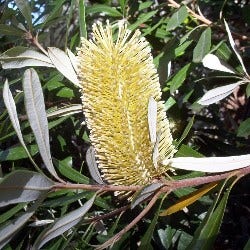
Banksia integrifolia - coast banksia
This big bold banksia is found from southern VIC, through NSW, right around to central QLD, in coastal sand dunes and high mountains. It grows alongside tea tree and paperbark in the wild. The dark green leaves are white beneath, very striking; and the pale greenish-yellow candles open into bristly yellow flowers. If you have the space coastal banksia is an easy choice as it seems happy to grow on clay, sand, acid or alkaline soils, in coastal salt spray or Blue Mountain bush.The only drawback is that in a protected sheltered garden it can get to 25m tall; on an exposed sea cliff it may stay a small 3-5m tree.
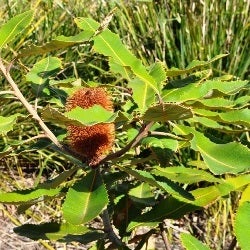
Banksia robur - swamp banksia
This bold rugged banksia is often found on pond and creek banks, river margins, floodplains, and sandy peaty soils, from the top of QLD to the bottom of NSW. It's wide, open, with large leaves and big chunky flowers that are blue-green in candle bud stage, opening to cream and yellow, maturing to gold before drying into bristly hairy grey cones.All these stages can be found on the bush together. New leaves are felty and tan-brown. Swamp banksia needs room, and more water than other banksias, but it's well worth accommodating it.
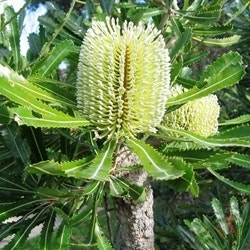
Banksia serrata - saw banksia
This tall popular banksia is also known by the common names of saw leafed banksia, old man banksia, and red honeysuckle. Saw leafed banksia is a hardy tree found as far south as TAS and the coastal tip of VIC, and thriving as far north as the Fraser Coast of QLD. As the name suggests the leaves are distinctively serrated along the edges, forming a ruff around the fat, pale cream flowers. They often open at night which brings in nocturnal mammals as well as day-visitor birds. Saw banksias are often gnarly, lumpy, twisted trees, short and compact in exposed coastal sites, and better at the back of the border in sheltered gardens. Pygmy Possum is a dwarf groundcover cultivar of saw banksia.
Other Garden-Friendly Species
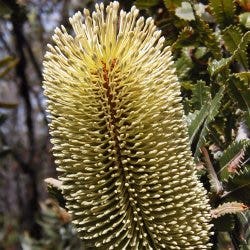
Banksia aemula - wallum banksia
This sprawly gnarly Banksia tree is found along the subtropical east coast from mid-QLD to mid-NSW, in beach dunes, coastal places, and sandy soils - which are called wallum in the native language. In the wild it grows beside paperbark, tea tree, grass tree, and scribbly gum.Wallum banksia has deep roots which can penetrate the sand for fresh water; although it grows in sand, it doesn't like drying out.The name 'aemula' means similar to, because it looks a lot like Banksia serrata, but with brown and not grey bark. The fat autumn-winter flowers are pale green-yellow .
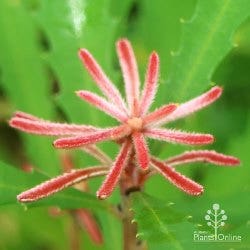
Banksia oblongifolia - fern leaf banksia
This big bushy Banksia is found along the east coast from mid-QLD to mid-NSW, in sandy soils and swampy sites, clay, loam and granite, in forest, bushland, and beachfront. Fern leaved banksia grows in similar places to wallum banksia, where it has access to more water. In the wild it is found alongside Epacris, Kunzea, paperbark and scribbly gum.Fern leaved banksia is also called rusty banksia, which makes more sense as the leaves aren't at all fern-like, rather leathery and dark.The fat autumn-winter flowers are pale green-yellow, and new leaves rust-brown and felty.
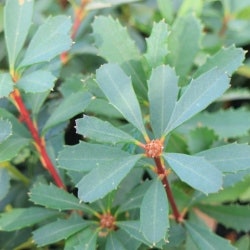
Banksia paludosa - marsh banksia
This small slow-growing Banksia is found in only a few places in the wild south of Sydney, in open spaces on dry rocky acid soil.In the wild it grows alongside Eucalyptus and Epacris. Marsh banksia is not often found in gardens, although the attractive rosettes of leaves, and furry russet-brown flower cones make it worth cultivating. It's a perfect size for pots and containers, unlike many other banksia species. And it can tolerate salt spray in coastal sites, and heavy frosts, which is useful for southern and inland gardens.Marsh banksia is the parent plant of the wildlife-friendly Little Pal
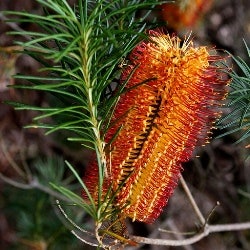
Banksia spinulosa - hairpin banksia
This delicate-looking, airy Banksia is found from the coast of southern VIC, right through NSW, around to central QLD;. It grows on sandy acid soils, and sometimes rocky clay, in open heath and shady bush. It is one of the most widely-distributed banksia, and can be found in the wild in a huge variety of climates and soils. It will likely do very well in your garden! Hairpin banksias are usually small, shrubby trees, or big open bushes; their open habit provides perching places for birds, and the flowers, pollen for native bees.
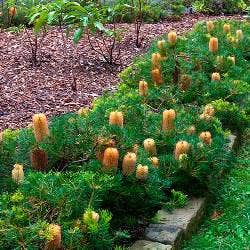 The neat cylinder flowers are usually rich orange-gold but their natural variability of colour and size means that hairpin banksia is very popular for hybridising.
The neat cylinder flowers are usually rich orange-gold but their natural variability of colour and size means that hairpin banksia is very popular for hybridising. It is the parent plant of many popular cultivars, including : Honey Pots, Black Magic, Dwarf Red, Stumpy Gold, Coastal Cushion, Birthday Candles, and Cherry Candles. Heath banksia and hairpin banksia cross-hybridise naturally, with manifold outcomes, and have produced the dwarf Bird Song, and the giant Giant Candles, among others.

















